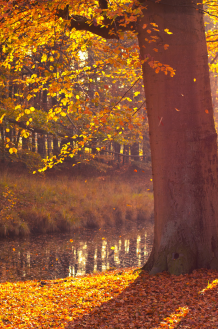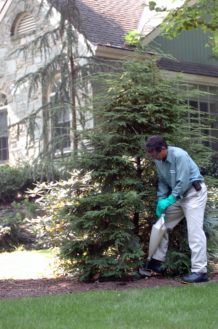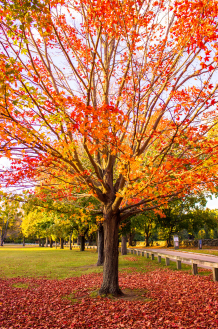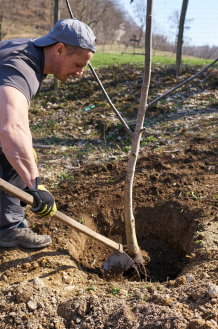- Tree planting in November
- Tree aftercare
- Tree maintenance
- The benefits of tree planting
Tree Planting in November
November is one of the best times for tree planting because trees enter their dormant season after leaves drop. So, in autumn, newly planted trees’ energy will go toward root growth.
Early spring, before buds break, is another ideal time for tree planting. However, if the ground is still frozen, it could make the planting take place later in the spring.
It takes two people to plant a tree in the ground properly. Before digging a hole, picking the perfect spot for your new tree is vital. Remember this mantra: Plant the right tree at the right place at the right time.
You need to consider your overall landscape design and these four other factors:
- The tree’s height at full maturity
How will that tree you’re considering adding to your property look like when it reaches full maturity? Many homeowners see a sapling and think, “This tree will be beautiful in my front yard.”
Learn more: How to Protect Your Trees and Shrubs for Winter.
However, most people can’t envision the sapling when it’s fully grown. At full maturity, your tree may dwarf your entire landscape, or you realize it’s planted too close to the house. Always read the plant tag for a realistic picture of your intended tree at full maturity.
- The tree’s width at full maturity
It would help if you also considered the tree’s width when fully grown. Will the full-grown tree overtake your home or other outdoor structures? Does it look out of place when it’s full-grown?
- The canopy’s width at maturity
A tree’s canopy includes the branches and leaves you can see when you look up at the tree. The canopy’s size matters because you can have a very wide or narrow tree canopy, depending on the tree species.
Again, you need to look at your landscape as a whole when the tree becomes full-sized. Will the canopy grow into outdoor structures? What shade will you get from this tree—full, dense, or dappled? Will this tree’s canopy interfere with other trees in your landscape?
- The tree’s debris
Have you considered the tree’s seeds, pinecones, or fruits that will drop? Again, you may love a particular tree species, but you must consider the tree’s debris. For example, the Ginkgo Biloba tree is beautiful with its fan-like leaves that provide constant shade during the spring and summer. In the fall, the leaves change to a bright golden yellow. Ginkgo Biloba trees are dioecious, which means the trees can be male or female. The female tree produces fruits that contain seeds. The odor will knock your socks off if you step on one of those noxious fruits. Plus, the fruits and seeds are toxic to people and pets. So, if you want to add a Ginkgo Biloba tree to your backyard, ensure it’s a male that doesn’t produce smelly fruit.

Tree Aftercare
After planting trees, ensure they have mulch to protect the roots from winter’s freeze/thaw periods. Also, it would help if you watered your tree after your landscape team has planted it.
Here’s how you should water your sapling after tree planting:
- For the first two weeks, daily water your trees unless there’s sufficient rainfall
- During weeks three through 12, water your trees every two to three days
- After 12 weeks, water your new trees weekly until roots take hold.
One DIY trick for watering saplings:
Drill holes in a 5-gallon bucket and put it next to the new tree. Try to fill the bucket and let the water slowly trickle out of the holes at the root zone.
Alternatively, you can invest in tree bubblers to deliver water to your new tree’s root system. There’s less water waste, and your young trees will get the water needed to develop deep roots. Soaker hoses with timers are another option for irrigating your new trees.
Tree Maintenance
When it comes to tree maintenance, you must ensure that your newly planted tree is anchored correctly so it grows in the right direction.
As your trees grow, you need to think about pruning them to keep their natural shape and eliminate any dead branches. You may also need to cut back tree branches that are rubbing against each other or that are growing too close to a building.
Don’t hire any tree care companies that top their trees. Tree topping is one of the worst things you can do to a tree. The tree looks ugly, and the new branches will be weaker and healthier after topping.
The goals for tree pruning include
- Only taking off branches that are interfering with other branches or structures.
- Pruning branches that are rubbing against other branches which causes insect infestation and disease damage
- Trimming tree branches that pose a danger during a storm to people and property
- Pruning to restore the natural beauty of the tree
- Pruning to remove any dead branches.
Ideally, you want to hire a certified arborist to handle your tree care needs. A certified arborist either trained as an apprentice with another arborist or went to school to learn about tree care.
At Tomlinson Bomberger, we have multiple arborists on staff who know all about tree care—from sapling to maturity.
 The Benefits of Tree Planting
The Benefits of Tree Planting
Planting trees will increase your home’s value for a variety of reasons. Here are three benefits of tree planting that add to your residential landscape:
- Social benefits such as helping you feel more relaxed and help with recovery time after a medical procedure.
- Economic benefits, including potentially raising your property value by 5% to 20% higher than non-landscaped homes. TreesAreGood.org says that the larger the tree, the greater the value. You also save money on your air conditioning and heating costs because of the tree’s shade in summer and how the tree acts as a windbreak in the winter.
- Environmental benefits include leaves filtering the air by removing dust, absorbing carbon monoxide and sulfur dioxide, and releasing oxygen. Trees are an essential part of reducing climate change effects.
Why You Need Tomlinson Bomberger for Tree Planting This Fall
The benefits of tree planting for your mental health, your property value, and the environment are all reasons why you should invest in tree planting this fall. At Tomlinson Bomberger, our arborists will work with you to find the right tree for the right place on your property. We also provide tree maintenance packages where our arborists will provide tree care services so your trees are vibrant and healthy. If you’re considering adding a new tree to your Central Pennsylvania property, call us today at 717-925-3309 or fill out our contact form.
Sources:
Extension.UMN.edu, Watering Newly Planted Trees and Shrubs.
LoveYourLandscape.org, 4 Things to Consider When Choosing Your Next Backyard Tree.
TheSpruce.com, How to Grow and Care for Ginkgo Biloba Trees.
TreesAreGood.org, Benefits of Trees. (pdf)
Ibid, Planting a Tree.

